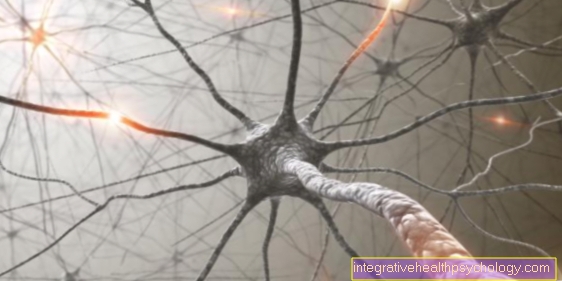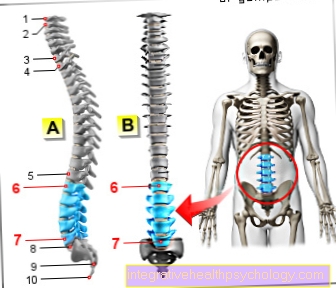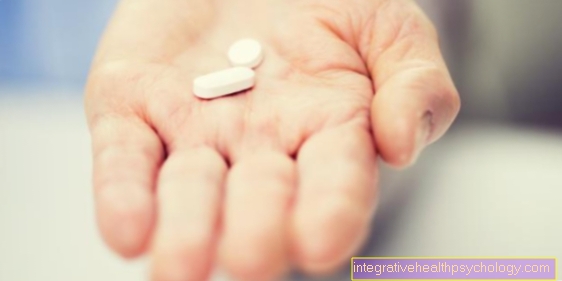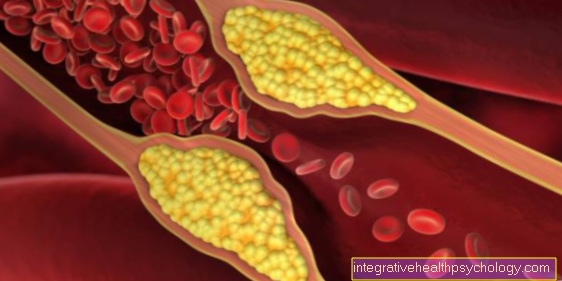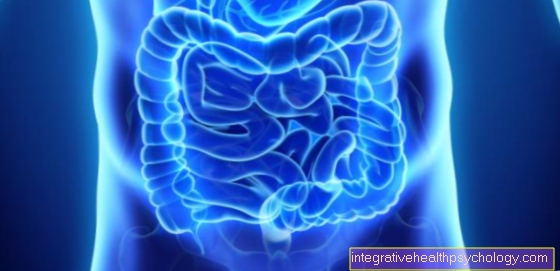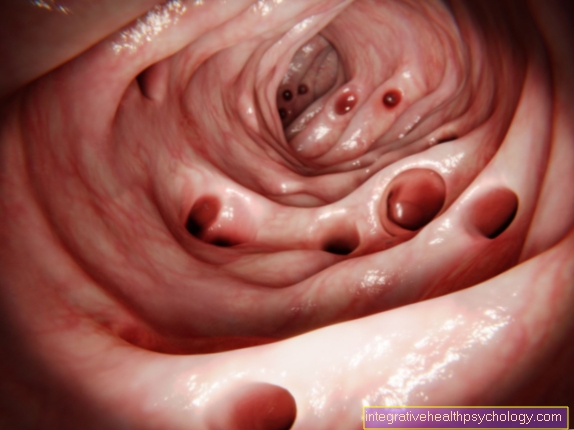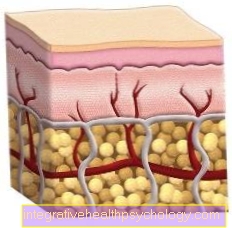Kidney disease
The kidneys are located on both sides of the spine and are one of the organs with the best blood supply. Its central task is to filter the blood and thus the production of urine, but also to regulate blood pressure and the production of some hormones is one of the tasks of the kidneys.
Diseases of the kidney manifest themselves with pain in the flank region, problems with urination or blood pressure derailments. In the following you will find a brief explanation of the most important diseases of the kidney as well as a reference to the main article of the respective disease with detailed information.
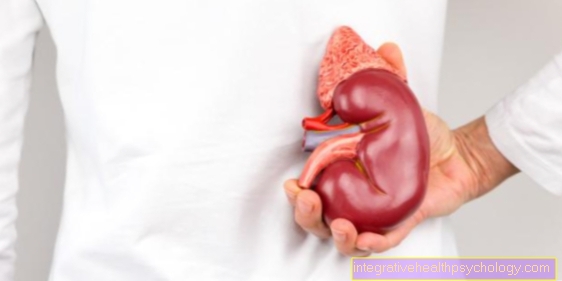
Classification
Below you will find the most common kidney diseases divided into:
- Inflammation of the kidney
- Structural kidney disease
- Functional kidney disease
- Other kidney diseases
Inflammation of the kidneys
Inflammation of the kidney corpuscles / glomerulonephritis
The kidney corpuscles (Glomeruli) are the smallest functional unit of the kidney and form the kidney's filter system. Inflammation of the kidney corpuscles can have many causes. They can occur after infections with certain pathogens (post-infectious) or in the context of various (auto) immunological diseases. They usually arise because antibody complexes are deposited in the kidney corpuscles. Symptoms of inflammation of the kidney corpuscles are based on the resulting defect in the filter system. This allows blood and proteins that are normally held back by the filter to enter the urine. If the filtration capacity decreases, edema can occur due to the accumulation of liquid. Chronic kidney failure can occur in the end-stage.
For more information, see Glomerulonephritis.
Pelvic inflammation
Inflammation of the kidney is one of the most common kidney diseases. The renal pelvis is the last station within the kidney before the filtrate (the primary urine) enters the ureter, through which it is carried on into the bladder. Ascending urinary tract infections can take the opposite route and reach the renal pelvis via the bladder ("cystitis") and the ureter and trigger an inflammation there. Symptoms typically include severe flank pain in the kidney area and painful urination. Kidney inflammation is a relatively serious clinical picture, but it can usually be treated well with antibiotics and cured in 1-2 weeks.
For details, see Pelvic inflammation.
Adrenal inflammation
The adrenal glands lie directly next to the kidneys, but are regarded as independent organs. Their main task is the production of various hormones. Inflammation of the adrenal glands usually occurs as an autoimmune reaction, which means that the immune system attacks the body's own structures. Inflammation can lead to adrenal insufficiency, in which the hormone production of the adrenal glands is so severely restricted that a healthy hormone balance can no longer be maintained. The lack of adrenal hormones (including cortisol, aldosterone and sex hormones) leads to symptoms such as nausea, weight loss, a drop in blood pressure or hypoglycaemia.
For details, see Adrenal inflammation.
Structural kidney disease
Kidney stones
Kidney stones are widespread in the population, around 5% of adults suffer from them, sometimes without even knowing it. The stones consist of different urine components, mostly calcium or uric acid stones. If these components of the urine are excessively high, they can no longer be adequately excreted by the kidneys and form stones within the kidney or the urinary tract. If stones are present individually and in favorable places such as the renal pelvis, they can remain asymptomatic and are often not noticed at all. If a kidney stone passes through constrictions, this can lead to severe, wave-like pain, known as renal colic. Urination problems are also possible. Various surgical methods are available for removing kidney stones.
For details, see Kidney stones.
Kidney cysts
Kidney cysts are fluid-filled cavities in the kidney tissue that occur primarily with increasing age. In the population over 60, one in five is affected. Individual kidney cysts usually do not cause symptoms. Very large cysts can cause problems and must be "emptied" with a puncture. A kidney cyst can rarely cause inflammatory reactions, which should be treated with antibiotics. It is important to differentiate between a kidney cyst and a cyst kidney. The latter is an independent genetic disease in which almost the entire kidney tissue is infested with cysts (polycystic kidney disease). Symptoms such as high blood pressure or kidney failure are correspondingly more serious.
For details, see Kidney cysts.
Kidney cancer / renal cell carcinoma
Kidney cancer is usually a so-called. Renal cell carcinoma. This cancer is comparatively rare and occurs mainly in old age, the peak of the disease is around 60-80 years. Symptoms of kidney cancer can include bloody urine, flank pain and weight loss. Since this cancer does not respond well to chemotherapy, the treatment of choice is a radical surgical removal of the entire affected kidney, including the adrenal gland and adjacent lymph nodes.
For details, see Kidney cancer.
Calcified kidney
If more calcium is deposited in the kidneys, the clinical picture of the calcified kidney develops. The reasons for this lie, as has already been suspected, in a disturbed calcium metabolism. In this case, the ultrasound examination is a quick and painless diagnostic procedure.
Are you interested in this topic? Read more about this in our next article: Calcified Kidney - Causes, Diagnosis & Therapy
Functional kidney disease
Diabetic kidney disease
In diabetic kidney disease (medical diabetic nephropathy) it is a loss of function of the kidneys, which occurs as a result of the diabetes mellitus. Permanently elevated blood sugar levels can, in conjunction with an usually equally elevated blood pressure, damage the fine kidney vessels and the kidney's filter system. Initially, for example, larger molecules such as proteins, which are normally held in the body by the filter, enter the urine. Over time, the kidney tissue dies and chronic kidney failure can occur. Diabetic nephropathy is the most common cause of dialysis treatment in Germany.
For details, see Diabetic nephropathy.
Acute kidney failure
Acute kidney failure is a serious clinical picture that usually requires intestinal inpatient treatment. Usually, however, it does not appear as an independent clinical picture, but in the context of more far-reaching illnesses, e.g. multi-organ failure, blood poisoning (sepsis) or burns. It is characterized by the fact that kidney function decreases acutely and urine output falls below 500ml / day (normally 1.5-2 liters). The patients then store fluid in the form of edema, for example in the legs or the lungs, the latter can lead to shortness of breath. In the treatment of acute kidney failure, the treatment of the underlying cause plays a role. Diuretics (water-removing drugs) can be used to try to increase kidney function. Dialysis is necessary in severe cases.
For details, see Acute kidney failure.
Renal insufficiency / chronic kidney failure
Renal insufficiency is a loss of function of the kidney, while acute kidney failure is also a form of renal insufficiency. In chronic kidney failure, which occurs, for example, as part of diabetes or other diseases, various stages are divided based on the filtration performance of the kidney, which usually decreases in the course of the disease. In addition to the accumulation of excess fluid in the body, the lack of elimination of certain substances is a particular problem. For example, the blood concentration of urea increases when the filtration efficiency of the kidney decreases. Urea in toxic quantities can cause various types of damage in the body, for example in the brain, heart or skin. The therapy of renal insufficiency is complex and includes approaches such as diet, drinking volume regulation, diuretics and, in the end-stage, dialysis. In addition, it is important to note that the dosage of painkillers in diseases of the kidney must be adapted to the rest of the function. The same applies to other groups of drugs such as antibiotics or cytostatics.
For details, see Renal failure.
Renal artery stenosis
A "stenosis" is a narrowing, in this case of the renal artery. The kidney is involved in regulating blood pressure. If too little blood enters the kidney due to a narrowing of the renal artery, the kidney mistakenly "measures" low blood pressure and activates various mechanisms to increase the general blood pressure. However, since this is not actually reduced in the rest of the body, but only in the kidneys, high blood pressure occurs in the body. A common cause of renal artery stenosis is vascular disease such as arteriosclerosis, which occurs particularly in older smokers. Therapeutically, the renal artery can be expanded again through an intervention, but various antihypertensive drugs are also used.
For details, see Renal artery stenosis.
Other kidney diseases
Information on other diseases of the kidney can be found here:
- Cushing's Syndrome
- Addison's disease
- Pheochromocytoma
- Wilms tumor






